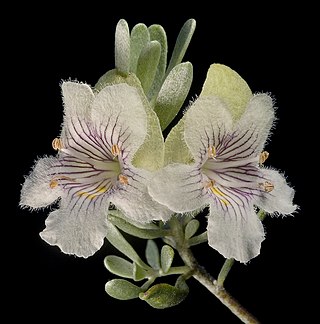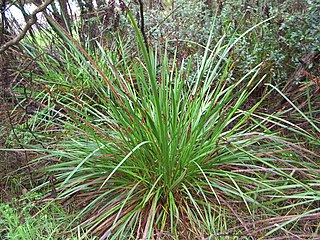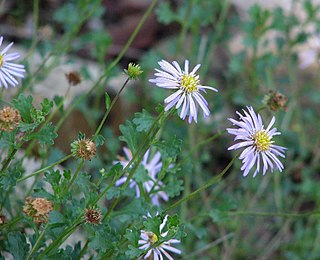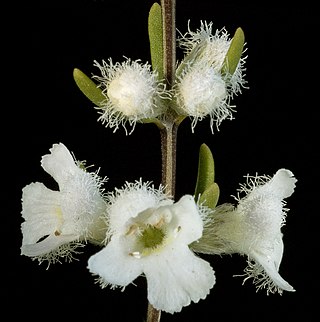
Scaevola is a genus of flowering plants in the Goodenia family, Goodeniaceae. It consists of more than 130 species, with the center of diversity being Australia and Polynesia. There are around 80 species in Australia, occurring throughout the continent, in a variety of habitats. Diversity is highest in the South West, where around 40 species are endemic.

Tribulus is a genus of plants in the family Zygophyllaceae and found in diverse climates and soils worldwide from latitudes 35°S to 47°N. The best-known member is T. terrestris, a widespread invasive species and weed.

Hakea is a genus of about 150 species of plants in the Family Proteaceae, endemic to Australia. They are shrubs or small trees with leaves that are sometimes flat, otherwise circular in cross section in which case they are sometimes divided. The flowers are usually arranged in groups in leaf axils and resemble those of other genera, especially Grevillea. Hakeas have woody fruit which distinguishes them from grevilleas which have non-woody fruit which release the seeds as they mature. Hakeas are found in every state of Australia with the highest species diversity being found in the south west of Western Australia.

Leucopogon is a genus of about 150-160 species of shrubs or small trees in the family Ericaceae, in the section of that family formerly treated as the separate family Epacridaceae. They are native to Australia, New Zealand, New Caledonia, the western Pacific Islands and Malaysia, with the greatest species diversity in southeastern Australia. Plants in this genus have leaves with a few more or less parallel veins, and tube-shaped flowers usually with a white beard inside.

Prostanthera, commonly known as mintbush or mint bush, is a genus of about 100 species of flowering plants in the mint family Lamiaceae, and all are endemic to Australia. Plants are usually shrubs, rarely trees with leaves in opposite pairs. The flowers are arranged in panicles in the leaf axils or on the ends of branchlets. The sepals are joined at the base with two lobes. The petals are usually blue to purple or white, joined in a tube with two "lips", the lower lip with three lobes and the upper lip with two lobes or notched.

Patersonia, is a genus of plants whose species are commonly known as native iris or native flag and are native to areas from Malesia to Australia.

Westringia is a genus of Australian shrubs. As with other members of the mint family their upper petal is divided into two lobes. There are four stamens - the upper two are fertile while the lower two are reduced to staminodes. The leaves are in whorls of 3 or 4.

Cassinia is a genus of about fifty-two species of flowering plants in the family Asteraceae that are native to Australia and New Zealand. Plants in the genus Cassinia are shrubs, sometimes small trees with leaves arranged alternately, and heads of white, cream-coloured, yellow or pinkish flowers surrounded by several rows of bracts.

Swainsona is a genus of about 85 species of flowering plants in the family Fabaceae, and is endemic to Australia. Plants in this genus are herbs or subshrubs with imparipinnate leaves and usually purple flowers similar to others in the family.

Calytrix is a genus of shrubs in the family Myrtaceae described as a genus in 1806. They are commonly known as starflowers. Calytrix are endemic to Australia, occurring in the.

Lepidosperma is a genus of flowering plant of the family Cyperaceae. Most of the species are endemic to Australia, with others native to southern China, southeast Asia, New Guinea, New Caledonia and New Zealand.

Calotis is a genus of herbs or small shrubs in the daisy family Asteraceae. Most of the species are native to Australia, while two occur in Asia.

Velleia is a genus of herbs in the family Goodeniaceae. Of the 22 species, 21 are endemic to Australia, and one is endemic to New Guinea. The genus was named by James Edward Smith, after Thomas Velley.

Styphelia is a genus of shrubs in the family Ericaceae, native from Indo-China through the Pacific to Australia. Most have minute or small leaves with a sharp tip, single, tube-shaped flowers arranged in leaf axils and with the ends of the petals rolled back with hairs in the inside of the tube.

Lumnitzera is an Indo-West Pacific mangrove genus in the family Combretaceae. An English common name is black mangrove. Lumnitzera, named after the German botanist, Stephan Lumnitzer (1750-1806), occurs in mangroves from East Africa to the Western Pacific, and northern Australia.

Schoenus is a predominately austral genus of sedges, commonly known as bogrushes, or veldrushes in South Africa. Species of this genus occur mainly in South Africa, Australia and Southeast Asia. Others are found in scattered locations worldwide, from Europe to Asia, North Africa and the Americas. Three species occur in the peatlands of southern South America, including S. antarcticus which is found in Tierra del Fuego, where it forms a component of hyperhumid Magellanic moorland.

Microcorys is a genus of flowering plants in the family Lamiaceae, first described in 1810. The entire genus is endemic to Australia.
- Microcorys barbataR.Br. - Western Australia
- Microcorys boxwoodNewbey - Western Australia
- Microcorys capitata(Bartl.) Benth. - Western Australia
- Microcorys cephalanthaB.J.Conn - Western Australia
- Microcorys ellipticaB.J.Conn - Northern Territory
- Microcorys eremophiloidesKenneally - Western Australia
- Microcorys ericifoliaBenth. - Western Australia
- Microcorys exsertaBenth. - Western Australia
- Microcorys glabra(Bartl.) Benth. - Western Australia
- Microcorys lenticularisF.Muell. - Western Australia
- Microcorys loganiaceaF.Muell. - Western Australia
- Microcorys longifloraF.Muell. - Western Australia
- Microcorys longifolia(Benth.) Benth. - Western Australia
- Microcorys macredieanaF.Muell. - Northern Territory
- Microcorys obovataBenth. - Western Australia
- Microcorys pimeloidesF.Muell. - Western Australia
- Microcorys purpureaR.Br. - Western Australia
- Microcorys queenslandicaC.T.White - Queensland
- Microcorys subcanescensBenth. - Western Australia
- Microcorys tenuifoliaBenth. - Western Australia
- Microcorys virgataR.Br. - Western Australia
- Microcorys wilsonianaB.J.Conn - Western Australia

Epacridoideae is a subfamily of the family Ericaceae. The name StyphelioideaeSweet is also used. The subfamily contains around 35 genera and 545 species. Many species are found in Australasia, others occurring northwards through the Pacific to Southeast Asia, with a small number in South America.


















